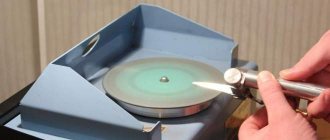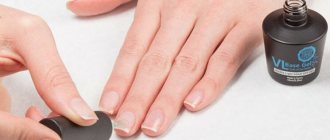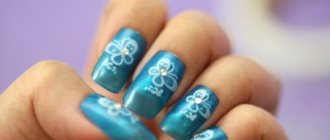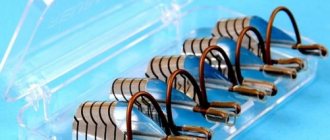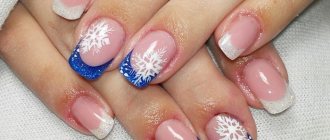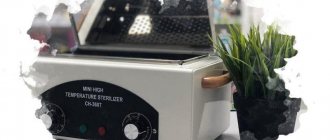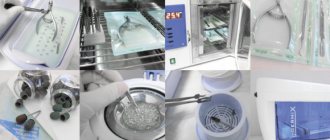Unfortunately, it is still quite common to see the following picture in a beauty salon: the hairdresser, having completed the haircut, shakes the hair off the comb with his hand and lays out the tools on the table, getting ready to serve the next client. Many hairdressers keep combs and razors in their pockets for trimming their temples, removable attachments for hair clippers are in the drawers of their bedside tables, and brushes for shaking hair from the face and neck are on the tables. Of course, such unsanitary conditions are more likely to be possible in some low-budget hairdressers and economy-class beauty salons, but, nevertheless, in higher-level enterprises there are deficiencies in sanitation.
As a result, according to specialists from the Research Institute of Disinfectology, from even high-class beauty salons, a client can bring home herpes, staphylococci and streptococci, warts and even pediculosis (lice), scabies, tuberculosis, hepatitis and HIV infection as a “bonus”.
You don’t need much to get infected; it’s enough to damage the scalp when combing the hair with a sharp comb, cutting the client with a clipper, scratching with a hard brush, or nail scissors. However, technicians can not only infect the client, but also become infected themselves.
In order for clients of beauty salons not only to become beautiful, but also to remain healthy, and for professionals to be guaranteed protected from infections, it is necessary to introduce safe technologies. The health of clients and beauty salon staff depends on how well informed salon employees are about the prevention of infectious diseases, disinfection and sterilization.
Sanitary standards require that each client of a beauty salon use a clean set of linen and, after each service, sterilize instruments that have had direct contact with the client. This includes hairdressing tools, tools for manicure and pedicure specialists, massage equipment, cosmetology tools and devices.
As experts conducting inspections explain, employees of beauty salons often break the rules not because of a reluctance to carry out such events, but simply because of a lack of appropriate knowledge and skills on sterilization issues or simply because of their own... bad manners. As a result, some specialists, even trying to comply with sanitary rules, often make serious mistakes: they use sterile gloves to take non-sterile things or believe that placing an instrument in an ultraviolet irradiator is sterilization (in fact, such preparations are only intended for storing instruments that have already been disinfected and sterilized ).
What is sterilization and how to carry it out correctly?
Sterilization (Latin sterilis - sterile) is the process of destroying all types of microbial flora and viruses using physical or chemical influences. Sterilization of products is carried out with the aim of killing all pathogenic and non-pathogenic microorganisms on them. Sterilization is carried out by physical (steam, air, in the environment of heated balls) and chemical (use of chemical solutions) methods. The choice of sterilization method depends on the characteristics of the products being sterilized.
The Ministry of Health of the Russian Federation, in accordance with the Federal Law of March 30, 1999 No. 52-FZ (as amended on July 23, 2013) “On the sanitary and epidemiological welfare of the population” (as amended and additionally entered into force on September 1, 2013) prescribes medical treatment for everyone -preventive institutions, as well as hairdressers, beauty salons, cosmetology centers and other beauty industry enterprises, strict adherence to the medical and technological sterilization process.
The medical-technological process of sterilization consists of the following stages:
- pre-treatment and disinfection of instruments;
- pre-sterilization cleaning;
- sterilization by one of the known methods;
- storage of sterilized products.
Each of these stages is regulated by the guidelines of the Ministry of Health of the Russian Federation.
DISINFECTION
All products, tools and devices must undergo disinfection. Since any instrument should be considered potentially infected, it must be disinfected immediately after completion of the service to prevent further spread of infection. Disinfection of products is carried out in order to destroy pathogenic and conditionally pathogenic microorganisms: viruses (including pathogens of parenteral viral hepatitis, HIV infection), bacteria (including tuberculosis microbacteria), fungi on instruments.
The tools used in the work are placed in a special container with a tight lid and soaked for at least an hour in a special disinfectant solution that destroys all pathogenic microorganisms.
Various chemicals are used for disinfection. When choosing a disinfectant, it is very important that it not only effectively fights pathogenic microorganisms, but is also safe for personnel. It's no secret that due to the use of disinfectants based on aggressive active ingredients, employees often develop allergic reactions: irritation of mucous membranes and skin, cough, swelling.
An important selection criterion is also the safety of the drug in relation to the processed products. It is unlikely that you will be satisfied with the disinfectant if, after several treatments, corrosion occurs on the instrument, which will be a consequence of the aggressive composition of the drug.
Nozzle material
The operation and purpose of the cutter depends on the material. The most popular are:
- Diamond. Relevant for treating the nail plate and skin. These cutters come in different levels of rigidity. When selecting, it is necessary to take into account the color of the notch.
- Carbide. Suitable for removing coatings, as they cut artificial material carefully and painlessly. The nozzle removes the surface in the form of chips, rather than grinding it into dust.
- Ceramic. The material includes quartz, clay, inert ash and feldspar. It is several times superior to carbide cutters. They do not heat up during operation. Ceramics ensure minimal vibration and soft cutting of material.
- Corundum. The special feature of the cutter is low heating of the surface. The material is of increased hardness, therefore it is optimal for processing calluses and cutting artificial material.
Sand caps are used to create a manicure. They treat keratinized skin and problem areas.
PRE-STERILIZATION CLEANING
Before sterilization, all instruments and devices must be subjected to pre-sterilization cleaning. The essence of this stage is to wash the instrument in running water or in special solutions, thereby cleaning it from possible residues of biological tissue (remove protein, fat and mechanical contaminants, as well as medications). Only pre-disinfected and absolutely clean instruments can be guaranteed to be sterilized. In addition, a tool that is cleaned regularly will not develop corrosion. Such a tool will last a long time and will not be a source of infection.
Pre-sterilization cleaning is carried out physically (under running water with your hands using brushes) or by mechanized methods. In the first case, cleaning is carried out under running water, and always cold, because the protein contaminants remaining on the instrument from the hot temperature can coagulate, and after that it will be very difficult to remove them.
Today, there are two mechanized cleaning methods: cleaning with ultrasonic washers and in washing-disinfecting machines. These devices combine pre-sterilization cleaning of instruments with disinfection.
Ultrasonic washers come in two types: without heating and with heating (to improve the quality of washing and speed up the process). The device works in the following way. High-frequency sound, propagating in a liquid (for example, in any disinfectant approved for these purposes), alternately creates waves of high and low pressure. They form millions of microscopic bubbles that immediately explode, releasing force many times greater than what you apply when brushing. In this case, dirt particles are torn off from the entire surface of the workpiece, and when the liquid is heated, even less time is spent on cleaning. Thus, in a matter of minutes you can obtain disinfection combined with pre-sterilization cleaning, without applying almost any physical effort.
Washer-disinfection machines, although they are more expensive than ultrasonic washers and the processing cycle takes longer, have a number of obvious advantages. Tool processing is carried out fully automatically. You just need to place the instrument in the basket/frame, select the appropriate program, and upon completion, remove the instrument from the machine, ready for sterilization.
Thanks to the closed system, not only can staff not develop an allergy to any drug, but the risk of accidental infection, which is very high when coming into contact with instruments, is also significantly reduced. In addition, possible negative consequences of the human factor are completely prevented, which can seriously affect the quality of pre-sterilization preparation and the condition of the instrument itself: non-compliance with the exposure time, inaccurate dosage of the disinfectant, etc.
The meaning of manicure cutter colors
The nozzles differ in abrasiveness: very soft, soft, hard and medium. The color of the notch allows you to determine this characteristic.
Milling cutters with greater rigidity for filing extended nails and processing them are marked with purple or black.
Blue color indicates elements of medium hardness, suitable for the outer layers of the skin. They cannot be used on the nail plate.
The green notch is applied to hard cutters that remove the artificial turf. They are practically not used in manicure.
Important! Mills with a green mark are not suitable for sensitive dermis.
Soft cutters used in manipulations with the epidermis and nail surface are marked in red. These attachments are universal and therefore suitable for cleaning pterygium.
Important! Sometimes you can see two red notches on the cutter. They mean increased softness of the material.
A yellow mark is applied to soft attachments. They are used for skin sensitivity and for working on the “native” nail plate.
White denotes ultra-soft attachments for small manipulations on the nail plate. They are used in very rare cases.
STERILIZATION
All products that come into contact with the wound surface, mucous membranes, come into contact with blood or injectable drugs, as well as instruments that during operation can cause damage to the skin, must be sterilized.
Currently, salon business enterprises use the following types of sterilizers :
- air thermal sterilizers;
- steam sterilizers;
- chemical sterilizers.
When purchasing a device, it is important to remember that any product intended for sterilization of a medical instrument must have permission from the Ministry of Health of the Russian Federation for mass production, as well as a certificate of conformity from Rosstandart of the Russian Federation (sanitary and epidemiological report, certificate of conformity and registration certificate from the Ministry of Health of the Russian Federation).
All sterilizable medical products can be divided into heat-sensitive (instruments with plastic parts, products made of plastic, rubber; various textiles) and resistant to high temperatures. Depending on the type of product, the method and types of sterilizers are chosen: hot air, steam or chemical.
Cutters shape
Different types of attachments are used for a certain stage of manicure, since they perform a single function. The most popular forms of cutters are:
- “needle” – lifts and opens the cuticle, removes the thin film around the nail, used for nail correction;
- “flame” - the nose of the cutter processes the sinus, and the flat zone protects the cuticle, the most convex part processes the ridges;
- “ball” – cuts off burrs on the sides and the cuticle layer, comes in different diameters;
- “cone” – lifts and reveals the protective layer;
- “corn” – removes extended nails, adjusts length;
- “cylinder” – reduces the length of the nail.
Important! When working with cutters, beginners should be careful not to injure the cuticle and the plate itself.
Air sterilizers
Air sterilizers can be called:
- dry air sterilizer;
- sterilization cabinet;
- dry heat cabinet;
- tendon.
According to GOST 27437-87, devices of this class are called “Air sterilizer”. Air sterilizers (the most common name is dry heat) use dry hot air for sterilization. The device itself resembles an oven familiar to our eyes. Sterilization takes place in a special chamber into which hot air is pumped using a fan. For sterilization, the temperature is usually set to 180 °C, which is maintained for an hour. The full operating cycle of a dry heater usually takes 3 hours: 1 hour heating, 1 hour temperature treatment, 1 hour cooling in the chamber.
The quality of sterilization using the air method depends on the uniform distribution of hot air in the sterilization chamber, which is achieved by correctly loading the sterilizer. Products are loaded in such quantities that allow free air supply to the product being sterilized. Products are sterilized wrapped in sterilization packaging materials.
Hot air sterilization is only suitable for simple instruments made entirely of metal. In addition, it should be remembered: hot air itself is a rather aggressive environment, which inevitably affects the service life of the tool.
Pros of dry heat:
- much cheaper than autoclaves.
Disadvantages of dry heat:
- there is a danger of damage to sterilized objects due to high temperature;
- Sterilizes only simple instruments;
- a fairly long sterilization cycle (at least 60 minutes);
- Plastic products cannot be processed.
Ultrasonic cleaning
An ultrasonic sterilizer involves the use of a disinfectant solution. Sound waves create vibrations, which help remove contaminants. The device is used before using a quartz or dry heat sterilizer.
An ultrasound device has the following advantages:
- Quick cleansing. 2–10 minutes is enough.
- Low energy consumption.
- High efficiency. The device copes with its main task perfectly: it removes dirt and rust even from hard-to-reach places.
- Versatility. The device can be used for processing glass, metal, plastic and ceramics.
- Gentle effect. The use of ultrasound helps prevent gross mechanical damage to instruments during cleaning.
- Low cost. The average price of the device is 2000–3000 rubles.
The device has one minus, but it is significant. Treatment in a solution does not remove all pathogens, so the device cannot cope with sterilization on its own. Ultrasound is used as an aid. The device also helps prevent rapid damage to instruments.
It’s not for nothing that these sterilizers are often called ultrasonic washers.
Steam sterilizers
Steam sterilizers can be called:
- hot steam sterilizer;
- wet sterilizer;
- autoclave.
According to GOST 27437-87, devices of this class are called “Steam Sterilizer”. Steam sterilizers (the most common name is autoclaves) use hot steam under pressure (0.8–3.5 bar) for sterilization. In this case, pathogens are destroyed at lower temperatures (110–135 °C).
Unlike dry heaters, autoclaves do not damage instruments and provide a shorter sterilization cycle. The steam sterilization method is the most desirable due to its versatility (you can sterilize any instruments, both packaged and unpacked; you can also sterilize rubber, plastic, and textile products). Steam sterilization is now the world's most common and preferred method of eliminating the risk of infection from contaminated instruments, recommended to health care workers by the World Health Organization (WHO) and the Center for Disease Control.
Autoclaves are divided into those with a pre-vacuum phase and a vacuum drying phase and those without a pre-vacuum phase (but they may have a vacuum drying). They perform the same functions: sterilization of materials and instruments, but the sterilization work cycle itself occurs technologically differently.
The European standard prEN 13060/1-4 divides autoclaves into three classes according to the descending line of requirements for them: “B”, “S” and “N”.
Class “B” autoclaves have the function of creating a preliminary vacuum and the function of vacuum drying at the end of the sterilization process. They can sterilize any type of medical instruments and materials: solid, hollow, porous, individually or double-packed of any type.
The function of creating a pre-vacuum in pulse mode is necessary to solve the following problem. Due to the fact that air cavities in sterilized objects can serve as a thermal insulator, steam treatment cannot always ensure complete sterilization of the instrument. Microorganisms are destroyed only upon contact with hot steam, and if contaminated air remains in the lumens of instruments or tips, then sterility will not be ensured. The pre-vacuum phase preceding the sterilization phase, or the vacuum cycle, makes it possible to remove contaminated air not only directly from the sterilizer chamber, but also from all cavities of the instrument being sterilized, ensuring the subsequent entry of hot steam into them.
Class B autoclaves meet the highest sterilization standards found in large clinical autoclaves. In such devices, sterilization of any instrument, linen and materials, with or without packaging, is allowed.
Class “S” autoclaves do not have a pre-vacuum phase, but they do have vacuum drying. Such machines are suitable for processing solid, smooth (unfolded) instruments, porous or wrapped materials, with or without packaging. They are more attractive in cost and are used in cases where the use of class “B” autoclaves is not required to sterilize instruments.
Class “S” autoclaves have lower power and some restrictions in the field of application. For example, they cannot sterilize some complex instruments with many internal cavities or items in multi-layer packaging.
Class “N” autoclaves are used to sterilize only unpackaged items without voids or crevices, all-metal instruments loaded directly into the autoclave chamber. Non-vacuum autoclaves are suitable for processing solid, smooth (unrolled) instruments and loose woven materials. Class “N” autoclaves are recommended for sterilization of simple solid products/instruments.
Chinese-made devices
Nowadays, Chinese-made dry-heat ovens (dry-heat ovens) are very popular in the beauty industry for sterilizing instruments. They are inexpensive, compact and easy to use. But when using such devices, you need to consider some points that we would like to talk about.
1. Today, most Chinese-made devices do not have all the necessary permits. If you work officially, then you will not pass the inspection of regulatory organizations with such a sterilizer - you will be fined! Check availability of all permitting documentation. 2. It follows from paragraph 1 that these sterilizers have not passed all the necessary tests, and cannot guarantee sterility and preservation of the sharpening quality of instruments after processing in them. It should be taken into account that many users of such devices talk and write that when using them, some of the craft bags burn, and for some, the indicators either work or do not work. This indicates that these devices cannot guarantee the maintenance of the temperature required by established standards throughout the entire volume of the working chamber, and in fact very strict restrictions on temperature deviation are established for dry-heat sterilizers. 3. Taking into account the rules of loading standards for sterilizers (laying in 1 layer for free passage of hot air), these sterilizers have quite modest capabilities in terms of the number of instruments to be sterilized.
The Sanitizing Box WX-12C device is worth considering separately.
Some also call it infrared. In fact, this device cannot be classified as either a classic air sterilizer or an infrared sterilizer of the ST-IK type. This is essentially a cross between an air and infrared sterilizer. At the same time, there are no regulated tool processing modes for it.
This sterilizer uses a different thermal method than air and infrared sterilizers. The modes that are used in air and infrared sterilizers are not suitable for it. Sterilization regimes for such sterilizers must be selected by the manufacturer in the process of research work and then confirmed by microbiological tests in special laboratories accredited for this purpose. After the full range of tests (microbiological, clinical, technical), permitting documents are issued: Registration Certificate, Declaration (Certificate) of Conformity. This sterilizer does not have a registration certificate, which means it has not passed the necessary tests. Considering all these circumstances, we would not recommend using this sterilizer to sterilize your instruments - you risk getting unsterile instruments or damaging your instruments if overheated.
What sterilizers should I buy for a beauty salon?
The main criteria in choosing a sterilizer, as well as any other equipment, are efficiency and reasonableness. A class “B” sterilizer is certainly effective, but its price is 2.5 times higher than that of an autoclave without using a vacuum. In terms of efficiency and versatility, an “N” class autoclave (without using a vacuum) is not inferior to any other option, and its price makes this choice the most acceptable for a beauty salon.
It should be remembered that this classification is accepted in Europe (European standard prEN 13060/1-4), but in our country it is not legally enshrined. In Russia, equipment for sterilization is divided into steam and air sterilizers (GOST 27437-87), therefore all legislative acts (GOSTs, SanPiN) regulating the work of medical and cosmetology institutions where sterilization is required put forward requirements for the operation of only the above sterilizers, and nowhere it is said that autoclaves must have a pre-vacuum phase and vacuum drying.
Depending on your salon's need for the number of objects to be sterilized, choosing an autoclave with the appropriate chamber size is of great importance. The greater the number of trays that fit into the chamber of the selected autoclave, the fewer cycles will be required to sterilize the entire volume of materials, which, in turn, will save time. The presence of automatic sterilization programs in the autoclave is very convenient for work. Currently, maintaining a record of the correct operation of the autoclave is of particular importance. If the autoclave model does not have a built-in printer, then it is desirable that there be an output for a standard printer connector and the possibility of subsequent (later) purchase of a printer.
Distilled water is used to operate autoclaves (to avoid corrosion from chlorine contained in ordinary water). Autoclaves with water heating outside the loading chamber are more economical in terms of distilled water consumption.
The autoclave operating cycle consists of three parts:
- preliminary preparatory phase;
- the actual sterilization phase;
- drying and cooling phase.
Advantages of autoclaves:
- the work uses a low temperature (121–135 °C), as a result the tool heats up less and, accordingly, becomes less dull;
- Sterilizes absolutely all types of instruments;
- short sterilization time - from 15 to 30 minutes.
Disadvantages of autoclaves:
- distilled water is required;
- high price.
Review of the most popular models
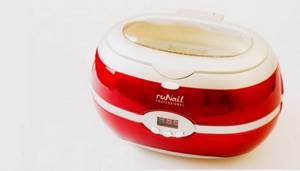
Irisk brand sterilizers are in greatest demand among craftsmen and ordinary consumers:
- Glasperlen Irisk 9010 Tango has a maximum temperature of 250 degrees, heats up in 20 minutes. Sterilizes manicure/pedicure instruments in 35 seconds. When the maximum temperature is reached, the light on the housing goes out. The balls are supplied complete with the device. Price – 2500 rub.
- The Irisk GP-10 dry-heat cabinet has a high cost (around 18,000 rubles), but it fully justifies it if purchased by cosmetologists or manicurists. Dimensions in each parameter do not exceed 45 cm, the duration of warming up to 180 degrees is half an hour.
- The Irisk ultrasonic sterilizer is equipped with a timer and display and processes placed instruments in 15 minutes. The model has compact dimensions and two color variations. Cleans not only manicure tools, but also jewelry. The cost of the device ranges from 4500 to 5000 rubles.
Budget analogues can be found in the brands RuNail and Jessnail, where they deserve special attention:
- Ultrasonic RuNail, which is a full replacement for the same device from Irisk, but costs 2500 rubles.
- Ball Jessnail 9008B heats up to 200 degrees, can be filled with quartz or glasperlene, processes tools for 30 seconds. Price – from 2000 to 2400 rubles.
Chemical sterilization
Chemical sterilization is the simplest method of sterilization. To do this, you only need to have a few hermetically sealed plastic containers of a suitable size and a chemical reagent. But do not forget that all chemical liquids are poisonous to one degree or another and therefore require careful handling and storage. It is also necessary to carefully follow the instructions for their use, since different reagents have their own scope and expiration date.
Sterilization of products with solutions of chemical agents is still an auxiliary method, since products cannot be sterilized in packaging, and after sterilization they must be washed with a sterile liquid (drinking water, 0.9 percent sodium chloride solution), which, if the rules of asepsis are violated, can lead to secondary contamination of sterilized products with microorganisms.
Disadvantages of the chemical method:
- the possibility of sterilizing packaged instruments and textiles is excluded;
- there is no way to dry the instrument under aseptic conditions, which sharply increases the risk of its contamination with pathogenic microflora;
- possibility of allergic reactions among staff.
The most common misconception regarding the sterilization of instruments is the belief that it can be done in ultraviolet sterilizers. The fact is that although ultraviolet radiation has a bactericidal effect, it is not able to sterilize the surface, since it only disinfects it. Thus, the bactericidal properties of these devices are sufficient only for disinfection and storage of sterilized instruments, and not for sterilization.
What to watch out for in a cosmetologist's office
Often visitors to beauty salons complain about suspiciously fast and poor-quality processing of tools after a previous client. Indeed, sometimes manicurists and cosmetologists simply wipe their working tools with an alcohol solution. This is unacceptable, because through a poorly processed nail file or scissors you can catch an infectious disease, for example, fungus, staphylococcus, or even worse.
Cosmetologists performing procedures on the skin must be extremely careful. Procedures such as facial cleansing and various injections require immediate and thorough sterilization of reusable instruments. Both work surfaces and large equipment in the beauty salon must be sterile. After all, not only the reputation of the salon or clinic itself depends on this, but also, above all, the client’s health.

If it is not possible to sterilize instruments according to all the rules, disposable materials are used (wipes, files, rags, gloves).
Such items are usually not very expensive, but in any case they will be the most reliable and practical solution to the problem.
